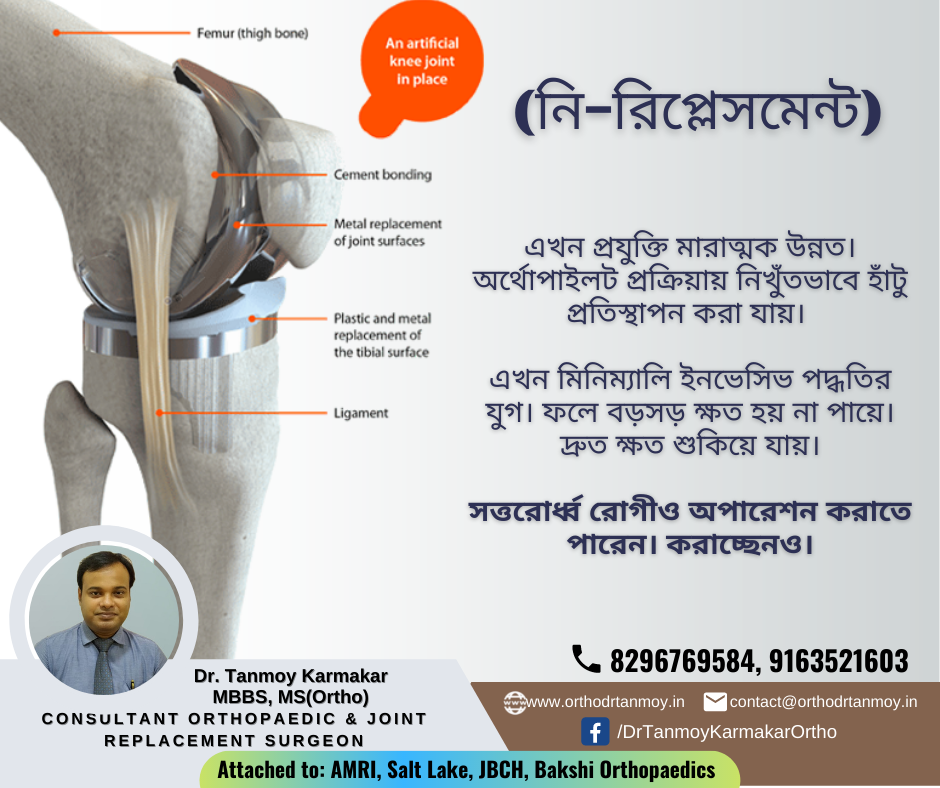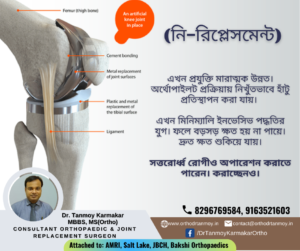

On this Blog Dr. Tanmoy Karmakar best Orthopedic & Joint Replacement Surgeon in Kolkata talks about Knee Replacement Surgery. Now-a-days, knee pain is very common and to get rid from this pain Knee Replacement surgery s a good option. Dr. Tanmoy karmakar performs Knee Replacement Surgery and the success rate is very high. Let’s go through some basics of knee replacement :-
What is knee replacement surgery? Why is it useful?
Knee replacement is a kind of arthroplasty. Arthroplasty literally means “the surgical repair of a joint,” and it involves the surgical reconstruction and replacement of degenerated joints, using artificial body parts, or prosthetics.
When the articular cartilage of the knee becomes damaged or worn, it becomes painful and the knee is hard to move. Instead of sliding over each other, the bones rub and crush together.
With a prosthesis, the patient will feel less pain, and the knee will move properly.
Why have knee replacement surgery?
There are three common reasons for the procedure:
Osteoarthritis: this type of arthritis is age related, caused by the normal wear and tear of the knee joint. It mostly affects patients aged over 50 years, but younger people may have it.
Osteoarthritis is caused by inflammation, breakdown, and the gradual and eventual loss of cartilage in the joints. Over time, the cartilage wears down and the bones rub together. To compensate, the bones often grow thicker, but this results in more friction and more pain.
Rheumatoid arthritis: also called inflammatory arthritis, the membrane around the knee joint to become thick and inflamed. Chronic inflammation damages the cartilage, causing soreness and stiffness.
Post-traumatic arthritis: this type of arthritis is due to a severe knee injury. When the bones around the knee break or the ligaments tear, this will affect the knee cartilage.
Who might need a knee replacement?
Knee surgery may be suitable for patients who experience:
- Severe knee pain or stiffness that prevents them from carrying out everyday tasks and activities, such as walking, going upstairs, getting in and out of cars, getting up from a chair
- Moderate but continuous knee pain that continues while sleeping or resting
- Chronic knee inflammation and swelling that does not improve after taking medications or resting
- Knee deformity, where there is a noticeable arch on the inside or outside of the knee
- Depression, resulting from an inability to carry out daily or social activities
If the other available treatment options have not worked, surgery may be the best option.
Types of knee replacement surgery
Knee replacement can be total or partial.
Total knee replacement (TKR): Surgery involves the replacement of both sides of the knee joint. It is the most common procedure.
Surgery lasts between 1 and 3 hours. The individual will have less pain and better mobility, but there will be scar tissue, which can make it difficult to move and bend the knees.
Partial knee replacement (PKR): Partial replacement replaces only one side of the knee joint. Less bone is removed, so the incision is smaller, but it does not last as long as a total replacement.
PKR is suitable for people with damage to only one part of the knee. Post-operative rehabilitation is more straightforward, there is less blood loss and a lower risk of infection and blood clots.
The hospital stay and recovery period are normally shorter, and there is a higher chance of more natural movement.
PREPARING FOR SUREGRY
Knee arthroplasty involves major surgery, so pre-operative preparation, medical consultations, and physical evaluations usually begin a month before the set date of the operation.
Preparatory and diagnostic tests will include checking blood count, seeing how the blood clots, carrying out electrocardiograms (ECGs), and urine tests.
Surgery is usually performed either under general, spinal, or epidural anesthetic.
During the procedure, the orthopedic surgeon will remove the damaged cartilage and bone, and then position the new implant, made of metal, plastic, or both, to restore the alignment and function of the knee.
RECOVERY
A patient who has knee replacement surgery will be hospitalized for 1 to 3 days, depending on how well they follow and respond to rehabilitation.
There will be pain, but a day after the procedure medical staff will encourage patients to get up and try to walk about, usually with some kind of walking aid. It is important to follow the instructions for rehabilitation.
Physical Therapies sessions aim to strengthen the knee. These may be painful, but they significantly reduce the risk of future complications.
Patients who do not have help at home may need to stay in the hospital for longer.
Recovering at home
According to the American Association of Hip and Knee Surgeons (AAHKS), it can take up to 3 months to recover completely from a knee replacement surgical procedure.
Patients can normally drive again after 4 to 6 weeks, and return to work after 6 to 8 weeks. Physical therapy may be provided for 3 months.
Patients must comply with the instructions given by doctors, nurses and the physical therapist.
The patient may be asked:
- To take iron supplements to aid wound healing and muscle strength
- Not to bend down and lift heavy things, at least for the first few weeks
- Not to stay standing still for long periods, as the ankles might swell
- To use crutches, a walking stick, or a walker until the knee is strong enough to take your body weight.
- To use all medications according to the instructions
- To carry out the recommended exercises to encourage proper mobility
- To keep the affected leg raised on a footstool when sitting
- To avoid soaking the wound until the scar is completely healed, because of the risk of infection
- To monitor for any signs and symptoms of infections, blood clots or pulmonary embolism.
Precautions should be taken to avoid a fall, as this might mean further surgery.
Useful measures include:
- Ensuring there is a secure handrail and using a stable, nonslip bench or chair in the shower
- Where possible, sleeping downstairs
- Securing any loose carpets and removing wrinkly mats around the house
- Removing or securing any trip hazards, such as loose wires
Most people can resume normal activities 6 weeks after the operation, but there may be some pain and swelling for up to 3 months, and scar tissue and muscles will still be healing for the next 2 years.
Items that may help at home include:
- A raised toilet seat
- A reaching stick for picking up items from the floor
- A long-handled shoe horn
Patients who have undergone knee replacement surgery can expect to participate in moderate and low-impact exercise activities, such as walking, swimming, and biking, but they should avoid extreme sports.